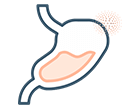Hyperbilirubinemia
The Igenomix Hyperbilirubinemia Precision Panel can be used to make a directed and accurate differential diagnosis of jaundice, ultimately leading to a better management and prognosis of the disease.


The Igenomix Hyperbilirubinemia Precision Panel can be used to make a directed and accurate differential diagnosis of jaundice, ultimately leading to a better management and prognosis of the disease. It provides a comprehensive analysis of the genes involved in this disease using next-generation sequencing (NGS) to fully understand the spectrum of relevant genes involved.
Hyperbilirubinemia is known as high amounts plasma bilirubin levels, causing a yellow discoloration of the skin, sclera, mucous membranes, and other less visible tissues in the newborn.
High levels of bilirubin can deposit and accumulate ultimately resulting in neurotoxicity. It can be physiologic or pathologic. There are two types of hyperbilirubinemia depending on the chemical structure of bilirubin: conjugated and unconjugated hyperbilirubinemia. Pathologic congenital causes of hyperbilirubinemia are: Crigler-Najjar syndrome type 1 and 2, Gilbert syndrome, Dubin-Johnson syndrome, and Rotor syndrome. These diseases are inherited mainly in an autosomal recessive pattern.
The clinical utility of this panel is:
Rets, A., Clayton, A. L., Christensen, R. D., & Agarwal, A. M. (2019). Molecular diagnostic update in hereditary hemolytic anemia and neonatal hyperbilirubinemia. International journal of laboratory hematology, 41 Suppl 1, 95–101. https://doi.org/10.1111/ijlh.13014
Watchko J. F. (2013). Genetics and pediatric unconjugated hyperbilirubinemia. The Journal of pediatrics, 162(6), 1092–1094. https://doi.org/10.1016/j.jpeds.2013.01.044